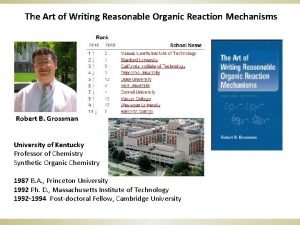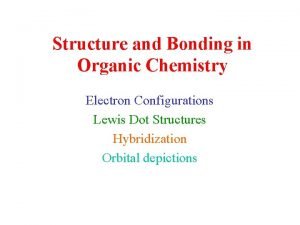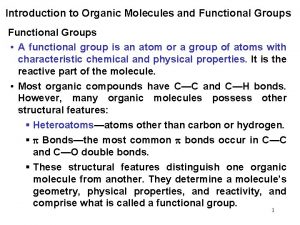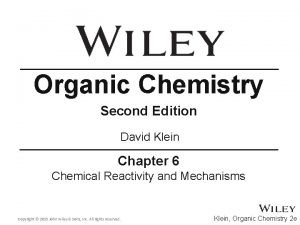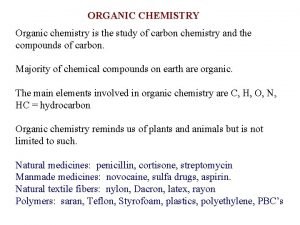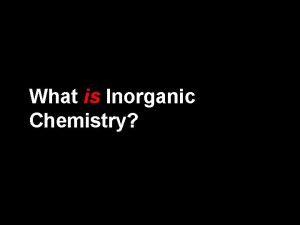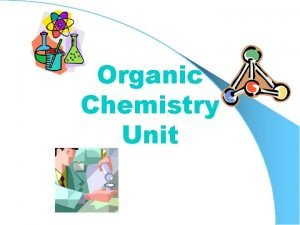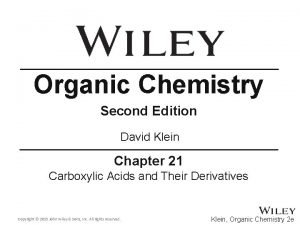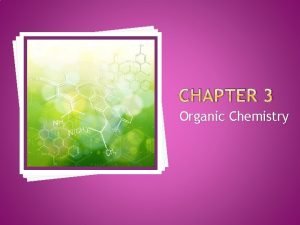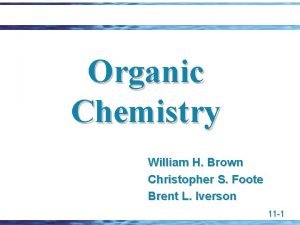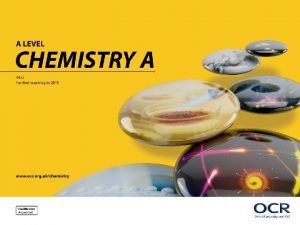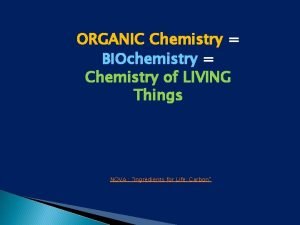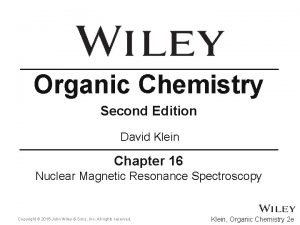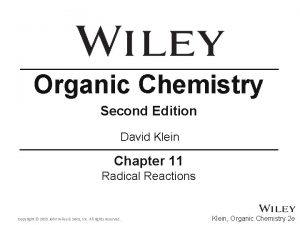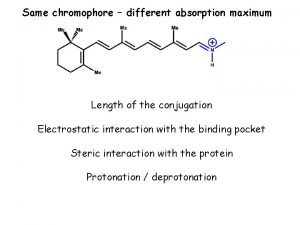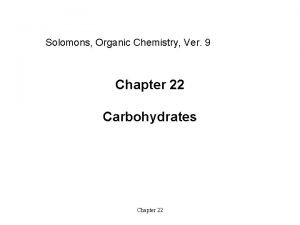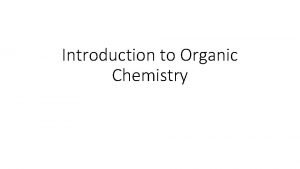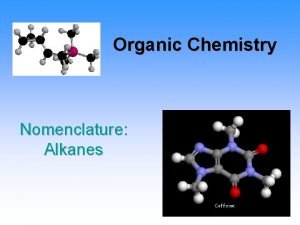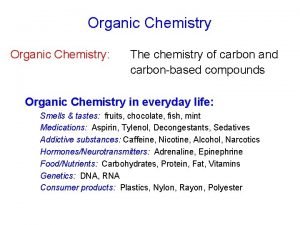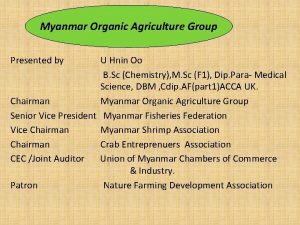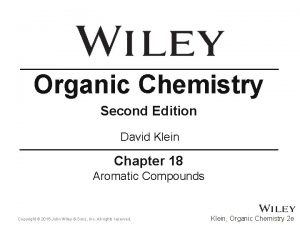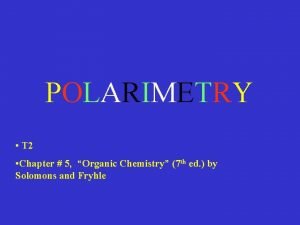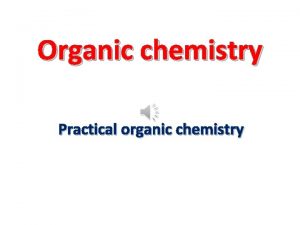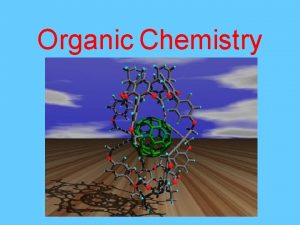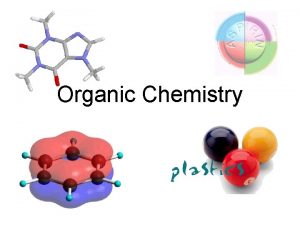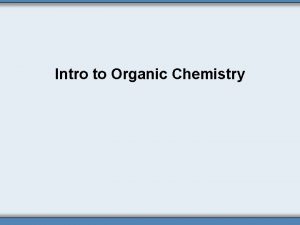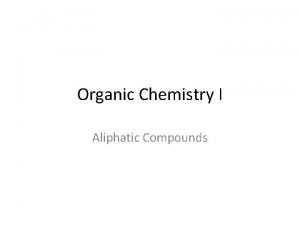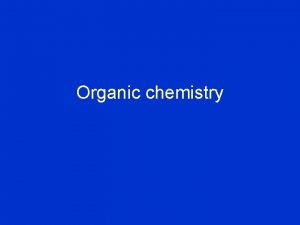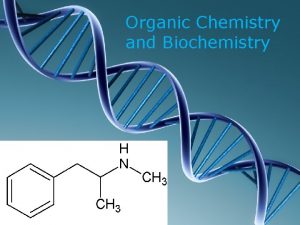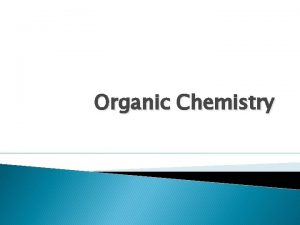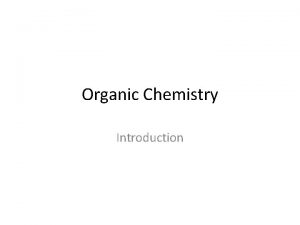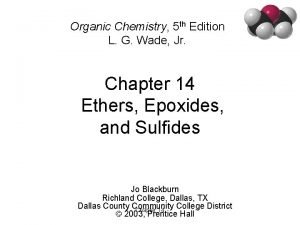Organic Chemistry 7 th Edition L G Wade





















































- Slides: 53

Organic Chemistry, 7 th Edition L. G. Wade, Jr. Chapter 11 Reactions of Alcohols Copyright © 2010 Pearson Education, Inc.

Types of Alcohol Reactions • • Dehydration to alkene Oxidation to aldehyde, ketone Substitution to form alkyl halide Reduction to alkane Esterification Tosylation Williamson synthesis of ether Chapter 11 2

Summary Table Chapter 11 3

Oxidation States • Easy for inorganic salts: § Cr. O 42 - reduced to Cr 2 O 3. § KMn. O 4 reduced to Mn. O 2. • Oxidation: Gain of O, O 2, or X 2; loss of H 2. • Reduction: Gain of H 2 (or H-); loss of O or O 2; and loss of X 2. • The gain or loss of H+, H 2 O, HX, etc. is neither an oxidation nor a reduction. Chapter 11 4

Oxidation States of Carbons Chapter 11 5

Oxidation of 2° Alcohols • 2° alcohol becomes a ketone. • Oxidizing agent is Na 2 Cr 2 O 7/H 2 SO 4. • Active reagent probably is H 2 Cr. O 4. • Color change is orange to greenishblue. Chapter 11 6

Oxidation Mechanism Chapter 11 7

Oxidation of 1° Alcohols to Carboxylic Acids • Chromic acid reagent oxidizes primary alcohols to carboxylic acids. • The oxidizing agent is too strong to stop at the aldehyde. Chapter 11 8

Pyridinium Chlorochromate (PCC) • PCC is a complex of chromium trioxide, pyridine, and HCl. • Oxidizes primary alcohols to aldehydes. • Oxidizes secondary alcohols to ketones. Chapter 11 9

Pyridinium Chlorochromate (PCC) Chapter 11 10

3° Alcohols Cannot Be Oxidized • Carbon does not have hydrogen, so oxidation is difficult and involves the breakage of a C—C bond. • Chromic acid test is for primary and secondary alcohols because tertiary alcohols do not react. Chapter 11 11

Other Oxidation Reagents • • • Cu. O, 300°C (industrial dehydrogenation) Collins reagent: Cr 2 O 3 in pyridine Jones reagent: chromic acid in acetone KMn. O 4 (strong oxidizer) Nitric acid (strong oxidizer) Swern oxidation: dimethylsulfoxide, with oxalyl chloride and hindered base, oxidizes 2 alcohols to ketones and 1 alcohols to aldehydes. Chapter 11 12

Solved Problem 1 Suggest the most appropriate method for each of the following laboratory syntheses. (a) cyclopentanol ––––––> cyclopentanone Solution Many reagents are available to oxidize a simple secondary alcohol to a ketone. For a laboratory synthesis, however, dehydrogenation is not practical, and cost is not as large a factor as it would be in industry. Most labs would have chromium trioxide or sodium dichromate available, and the chromic acid oxidation would be simple. PCC and the Swern oxidation would also work, although these reagents are more complicated to prepare and use. Chapter 11 13

Solved Problem 1 (Continued) Suggest the most appropriate method for each of the following laboratory syntheses. (b) 2 -octen-l-ol ––––––> 2 -octenal (structure below) Solution This synthesis requires more finesse. The aldehyde is easily over-oxidized to a carboxylic acid, and the double bond reacts with oxidants such as KMn. O 4. Our choices are limited to PCC or the Swern oxidation. Chapter 11 14

Dehydrogenation of Alcohols The dehydrogenation of alcohols is not used in laboratory settings because many compounds do not survive the reaction temperature of 300°C. Chapter 11 15

Swern Oxidation • This reaction uses dimethyl sulfoxide (DMSO) as the oxidizing agent along with oxalyl chloride and pyridine. • Primary alcohols can be oxidized to the aldehyde. • Secondary alcohols can be oxidized to the corresponding ketone with this reaction as well. • The by-products of this reaction can be easily separated from the products, making this a convenient reaction. Chapter 11 16

Example of the Swern Oxidation Chapter 11 17

Biological Oxidation • Catalyzed by alcohol dehydrogenase (ADH). • Oxidizing agent is nicotinamide adenine dinucleotide (NAD+). • Ethanol oxidizes to acetaldehyde, then acetic acid, which is a normal metabolite. • Methanol oxidizes to formaldehyde, then formic acid, which is more toxic than methanol. • Ethylene glycol oxidizes to oxalic acid, which is toxic. • Treatment for poisoning is excess ethanol. Chapter 11 18

Enzymatic Oxidation Alcohol dehydrogenase catalyzes an oxidation: the removal of two hydrogen atoms from an alcohol molecule. The oxidizing agent is called nicotinamide adenine dinucleotide (NAD+). Chapter 11 19

Alcohol as a Nucleophile H C O R X • ROH is a weak nucleophile. • RO- is a strong nucleophile. • New O—C bond forms; O—H bond breaks. Chapter 11 20

Alcohol as an Electrophile • OH- is not a good leaving group. • Protonation of the hydroxyl group converts it into a good leaving group (H 2 O). • Alcohols can be converted to a tosylate ester. • The tosylate group is an excellent leaving group. Chapter 11 21

Substitution and Elimination Reactions Using Tosylates Chapter 11 22

SN 2 Reactions with Tosylates • The reaction shows the SN 2 displacement of the tosylate ion (-OTs) from (S)-2 -butyl tosylate with inversion of configuration. • The tosylate ion is a particularly stable anion, with its negative charge delocalized over three oxygen atoms. Chapter 11 23

Summary of Tosylate Reactions Chapter 11 24

Reduction of Alcohols • Dehydrate with concentrated H 2 SO 4, then add H 2. • Make a tosylate, then reduce it with Li. Al. H 4. OH CH 3 CHCH 3 H 2 SO 4 alcohol OH CH 3 CHCH 3 alcohol CH 2 CHCH 3 alkene Ts. Cl OTs CH 3 CHCH 3 tosylate Chapter 11 H 2 Pt Li. Al. H 4 CH 3 CH 2 CH 3 alkane 25

Reaction of Alcohols with Acids • The hydroxyl group is protonated by an acid to convert it into a good leaving group (H 2 O). • Once the alcohol is protonated a substitution or elimination reaction can take place. Chapter 11 26

Reaction with HBr • • –OH of alcohol is protonated. –OH 2+ is good leaving group. 3° and 2° alcohols react with Br- via SN 1. 1° alcohols react via SN 2. + R O H H 3 O H R O H Chapter 11 - Br R Br 27

Reaction with HCl • Chloride is a weaker nucleophile than bromide. • Add Zn. Cl 2, which bonds strongly with –OH, to promote the reaction. • The chloride product is insoluble. • Lucas test: Zn. Cl 2 in concentrated HCl: § 1° alcohols react slowly or not at all. § 2 alcohols react in 1 -5 minutes. § 3 alcohols react in less than 1 minute. Chapter 11 28

SN 2 Reaction with the Lucas Reagent • Primary alcohols react with the Lucas reagent (HCl and Zn. Cl 2) by the SN 2 mechanism. • Reaction is very slow. The reaction can take from several minutes to several days. Chapter 11 29

SN 1 Reaction with the Lucas Reagent Secondary and tertiary alcohols react with the Lucas reagent (HCl and Zn. Cl 2) by the SN 1 mechanism. Chapter 11 30

Limitations of HX Reactions • Poor yields of alkyl chlorides from primary and secondary alcohols. • Elimination competes with substitution. • Carbocation intermediate may undergo a rearrangement. • Limited ability to make alkyl halides. Chapter 11 31

Solved Problem 2 When 3 -methyl-2 -butanol is treated with concentrated HBr, the major product is 2 -bromo-2 methylbutane. Propose a mechanism for the formation of this product. Solution The alcohol is protonated by the strong acid. This protonated secondary alcohol loses water to form a secondary carbocation. Chapter 11 32

Solved Problem 2 (Continued) Solution (Continued) A hydride shift transforms the secondary carbocation into a more stable tertiary cation. Attack by bromide leads to the observed product. Chapter 11 33

Reactions with Phosphorus Halides • • Good yields with 1° and 2° alcohols. PCl 3 for alkyl chlorides (but SOCl 2 better). PBr 3 for alkyl bromides. P and I 2 for alkyl iodides (PI 3 not stable). Chapter 11 34

Mechanism with PBr 3 • Oxygen attacks the phosphorus, displacing one of the halides. • Br- attacks back-side (SN 2). Chapter 11 35

Reaction of Alcohols with Thionyl Chloride • Thionyl chloride (SOCl 2) can be used to convert alcohols into the corresponding alkyl chloride in a simple reaction that produces gaseous HCl and SO 2. Chapter 11 36

Mechanism of Thionyl Chloride Reaction Chapter 11 37

Dehydration Reactions • • • Concentrated H 2 SO 4 produces alkene. Carbocation intermediate Zaitsev product Bimolecular dehydration produces ether. Low temp, 140°C and below, favors ether formation. • High temp, 180°C and above, favors alkene formation. Chapter 11 38

Dehydration of Cyclohexanol • The dehydration of cyclohexanol with H 2 SO 4 has three steps: Protonation of the hydroxide, loss of water, and deprotonation. • Alcohol dehydration generally takes place through the E 1 mechanism. Rearrangements are possible. • The rate of the reaction follows the same rate as the ease of formation of carbocations: 3 o > 2 o > 1 o. Chapter 11 39

Energy Diagram, E 1 Chapter 11 40

Solved Problem 3 Predict the products of sulfuric acid-catalyzed dehydration of 1 -methylcyclohexanol Solution 1 -Methylcyclohexanol reacts to form a tertiary carbocation. A proton may be abstracted from any one of three carbon atoms. The two secondary atoms are equivalent, and abstraction of a proton from one of these carbons leads to the trisubstituted double bond of the major product. Abstraction of a methyl proton leads to the disubstituted double bond of the minor product. Chapter 11 41

Unique Reactions of Diols Vicinal diols can undergo the following two reactions: § Pinacol rearrangement § Periodic acid cleavage Chapter 11 42

Pinacol Rearrangement • In the pinacol rearrangement, a vicinal diol converts to the ketone (pinacolone) under acidic conditions and heat. • The reaction is classified as a dehydration since a water molecule is eliminated from the starting material. Chapter 11 43

Mechanism of the Pinacol Rearrangement • The first step of the rearrangement is the protonation and loss of a water molecule to produce a carbocation. Chapter 11 44

Mechanism of the Pinacol Rearrangement (Continued) • There is a methyl shift to form a resonancestabilized carbocation, which upon deprotonation by water, yields the pinacolone product. Chapter 11 45

Periodic Cleavage of Glycols • Glycols can be oxidatively cleaved by periodic acid (HIO 4) to form the corresponding ketones and aldehydes. • This cleavage can be combined with the hydroxylation of alkenes by osmium tetroxide or cold potassium permanganate to form the glycol and the cleavage of the glycol with periodic acid. • Same products formed as from ozonolysis of the corresponding alkene. Chapter 11 46

Esterification • • • Fischer: Alcohol + carboxylic acid Tosylate esters Sulfate esters Nitrate esters Phosphate esters Chapter 11 47

Fischer Esterification • Reaction of an alcohol and a carboxylic acid produces an ester. • Sulfuric acid is a catalyst. • The reaction is an equilibrium between starting materials and products, and for this reason, the Fischer esterification is seldom used to prepare esters. Chapter 11 48

Reaction of Alcohols with Acyl Chlorides • The esterification reaction achieves better results by reacting the alcohol with an acyl chloride. • The reaction is exothermic and produces the corresponding ester in high yields with only HCl as a by-product. Chapter 11 49

Nitrate Esters • The best known nitrate ester is nitroglycerine, whose systematic name is glyceryl trinitrate. • Glyceryl nitrate results from the reaction of glycerol (1, 2, 3 -propanetriol) with three molecules of nitric acid. Chapter 11 50

Phosphate Esters Chapter 11 51

Phosphate Esters in DNA Chapter 11 52

Alkoxide Ions: Williamson Ether Synthesis • Ethers can be synthesized by the reaction of alkoxide ions with primary alkyl halides in what is known as the Williamson ether synthesis. • This is an SN 2 displacement reaction and as such, works better with primary alkyl halides to facilitate back-side attack. • If a secondary or tertiary alkyl halide is used, the alkoxide will act as a base and an elimination will take place. Chapter 11 53
 Kiliani fischer synthesis
Kiliani fischer synthesis Thermodynamic vs kinetic control
Thermodynamic vs kinetic control Organic chemistry third edition david klein
Organic chemistry third edition david klein Organic chemistry 2nd edition klein
Organic chemistry 2nd edition klein Halohydrin formation
Halohydrin formation Acid chloride + grignard reagent
Acid chloride + grignard reagent John wiley & sons, inc.
John wiley & sons, inc. Organic chemistry david klein 3rd edition
Organic chemistry david klein 3rd edition Nomenclature of ethers
Nomenclature of ethers Organic chemistry second edition david klein
Organic chemistry second edition david klein Ib chemistry organic chemistry
Ib chemistry organic chemistry Inorganic chemistry vs organic chemistry
Inorganic chemistry vs organic chemistry Organic chemistry
Organic chemistry Organic chemistry
Organic chemistry Ee organic chemistry
Ee organic chemistry Octane lewis structure
Octane lewis structure Functional group
Functional group Calculate percentage yield
Calculate percentage yield Hammonds postulate
Hammonds postulate Soap organic chemistry
Soap organic chemistry Chemistry organic
Chemistry organic What is organic chemistry like
What is organic chemistry like Organic biochemistry
Organic biochemistry Gc organic chemistry
Gc organic chemistry Organic chemistry
Organic chemistry Objective lab report example
Objective lab report example Organic chemistry
Organic chemistry Chemistry mind map
Chemistry mind map Brooklyn college organic chemistry
Brooklyn college organic chemistry Chapter 3 organic chemistry
Chapter 3 organic chemistry Acidic cleavage of ethers
Acidic cleavage of ethers A level chemistry ocr organic synthesis
A level chemistry ocr organic synthesis Organic chemistry nova
Organic chemistry nova Chapter 22 review organic chemistry section 1 answers
Chapter 22 review organic chemistry section 1 answers Organic chemistry
Organic chemistry Nbs reaction
Nbs reaction Conjugation organic chemistry
Conjugation organic chemistry Organic chemistry chapter 1
Organic chemistry chapter 1 Oxidation of carbohydrates
Oxidation of carbohydrates Leveling effect organic chemistry
Leveling effect organic chemistry Organic chemistry chapter 9
Organic chemistry chapter 9 Organic chemistry
Organic chemistry Ester organic chemistry
Ester organic chemistry Organic chemistry class 11 notes
Organic chemistry class 11 notes Organic vs inorganic
Organic vs inorganic Isomers of c7 h16
Isomers of c7 h16 Organic chemistry myanmar
Organic chemistry myanmar Hono organic chemistry
Hono organic chemistry Ethos
Ethos Organic chemistry conversion chart
Organic chemistry conversion chart Organic chemistry
Organic chemistry Organic chemistry chapter 1 problem 59pp
Organic chemistry chapter 1 problem 59pp Difference between fats and oils in organic chemistry
Difference between fats and oils in organic chemistry Polarimetry organic chemistry
Polarimetry organic chemistry












